Reward Management Report: Nestle's Approach to Employee Rewards
VerifiedAdded on 2022/12/27
|23
|5551
|2
Report
AI Summary
This report delves into the intricacies of reward management, examining its strategic importance in aligning employee contributions with organizational goals. The study employs Nestle as a case study, highlighting its innovative approach to reward systems, particularly its utilization of SAP technology and collaborative work environments. The report dissects key perspectives informing reward decisions, analyzing internal and external factors impacting reward strategies. It explores the principles of total rewards, emphasizing equity, fairness, consistency, and transparency in policy implementation. Furthermore, the report examines the role of line managers in reward decisions, considering the impact of both extrinsic and intrinsic rewards on employee performance and organizational success. The analysis includes examples of gathering and presenting reward intelligence, offering valuable insights into effective reward management practices. This report is a valuable resource for understanding reward management within the context of a global company.
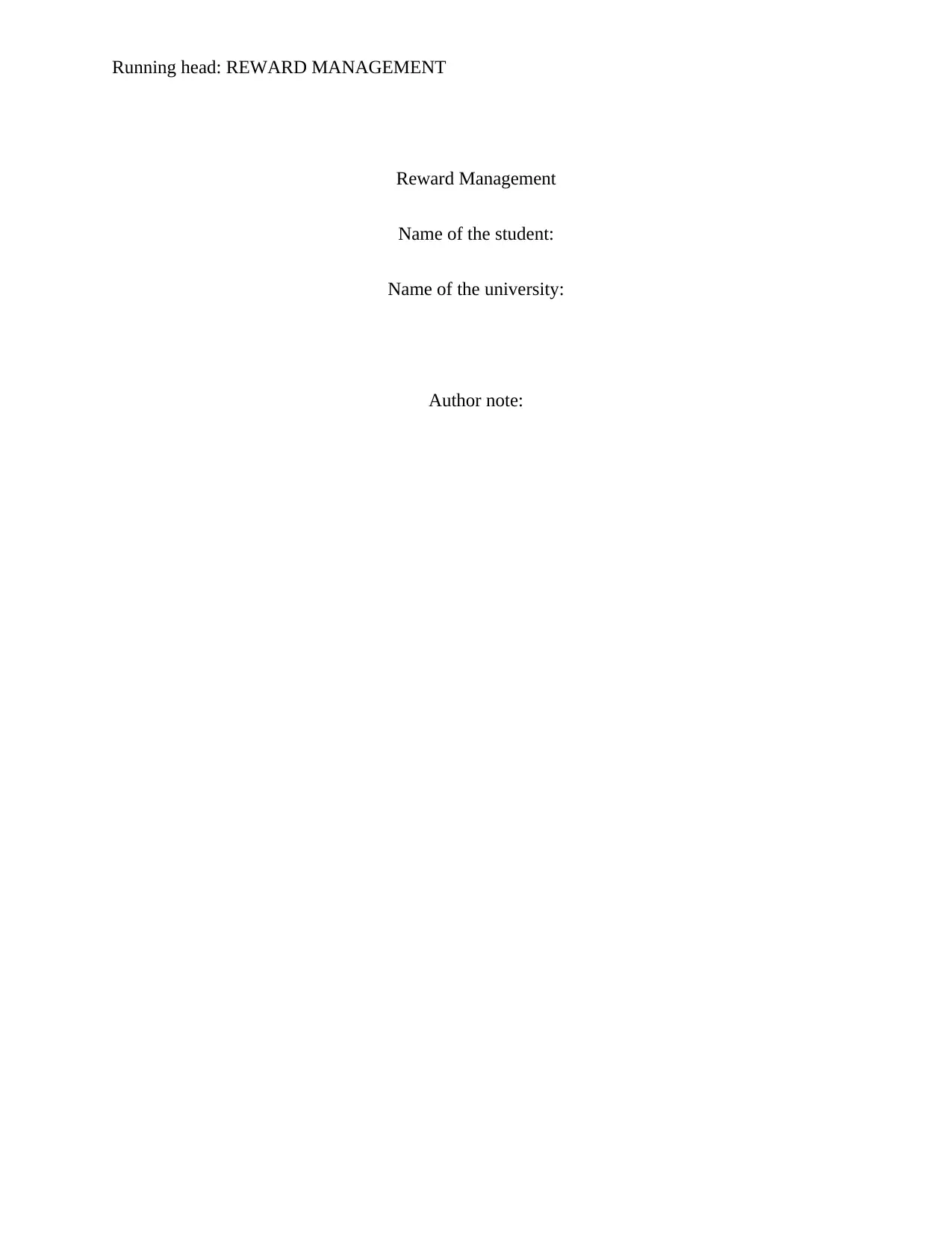
Running head: REWARD MANAGEMENT
Reward Management
Name of the student:
Name of the university:
Author note:
Reward Management
Name of the student:
Name of the university:
Author note:
Paraphrase This Document
Need a fresh take? Get an instant paraphrase of this document with our AI Paraphraser
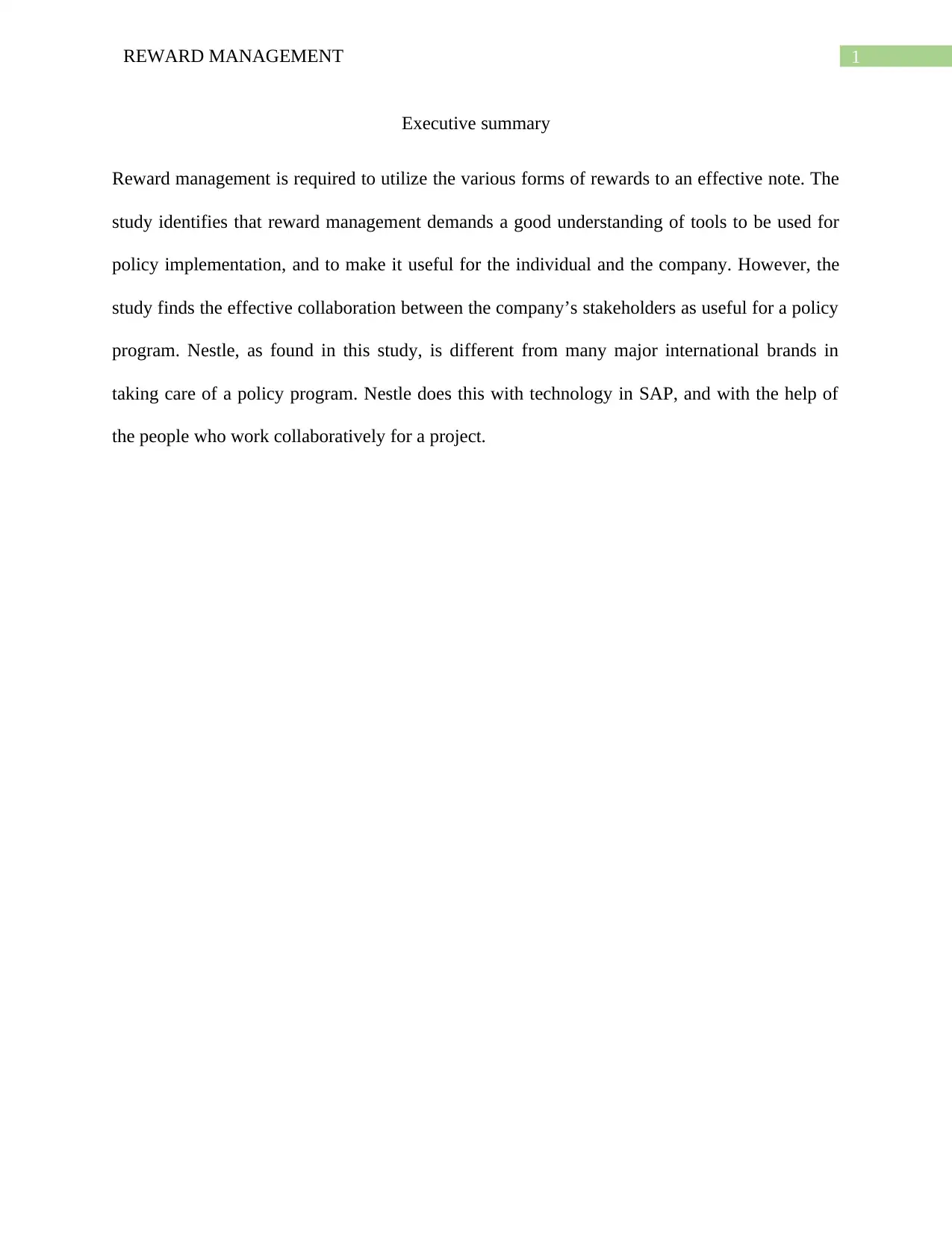
1REWARD MANAGEMENT
Executive summary
Reward management is required to utilize the various forms of rewards to an effective note. The
study identifies that reward management demands a good understanding of tools to be used for
policy implementation, and to make it useful for the individual and the company. However, the
study finds the effective collaboration between the company’s stakeholders as useful for a policy
program. Nestle, as found in this study, is different from many major international brands in
taking care of a policy program. Nestle does this with technology in SAP, and with the help of
the people who work collaboratively for a project.
Executive summary
Reward management is required to utilize the various forms of rewards to an effective note. The
study identifies that reward management demands a good understanding of tools to be used for
policy implementation, and to make it useful for the individual and the company. However, the
study finds the effective collaboration between the company’s stakeholders as useful for a policy
program. Nestle, as found in this study, is different from many major international brands in
taking care of a policy program. Nestle does this with technology in SAP, and with the help of
the people who work collaboratively for a project.
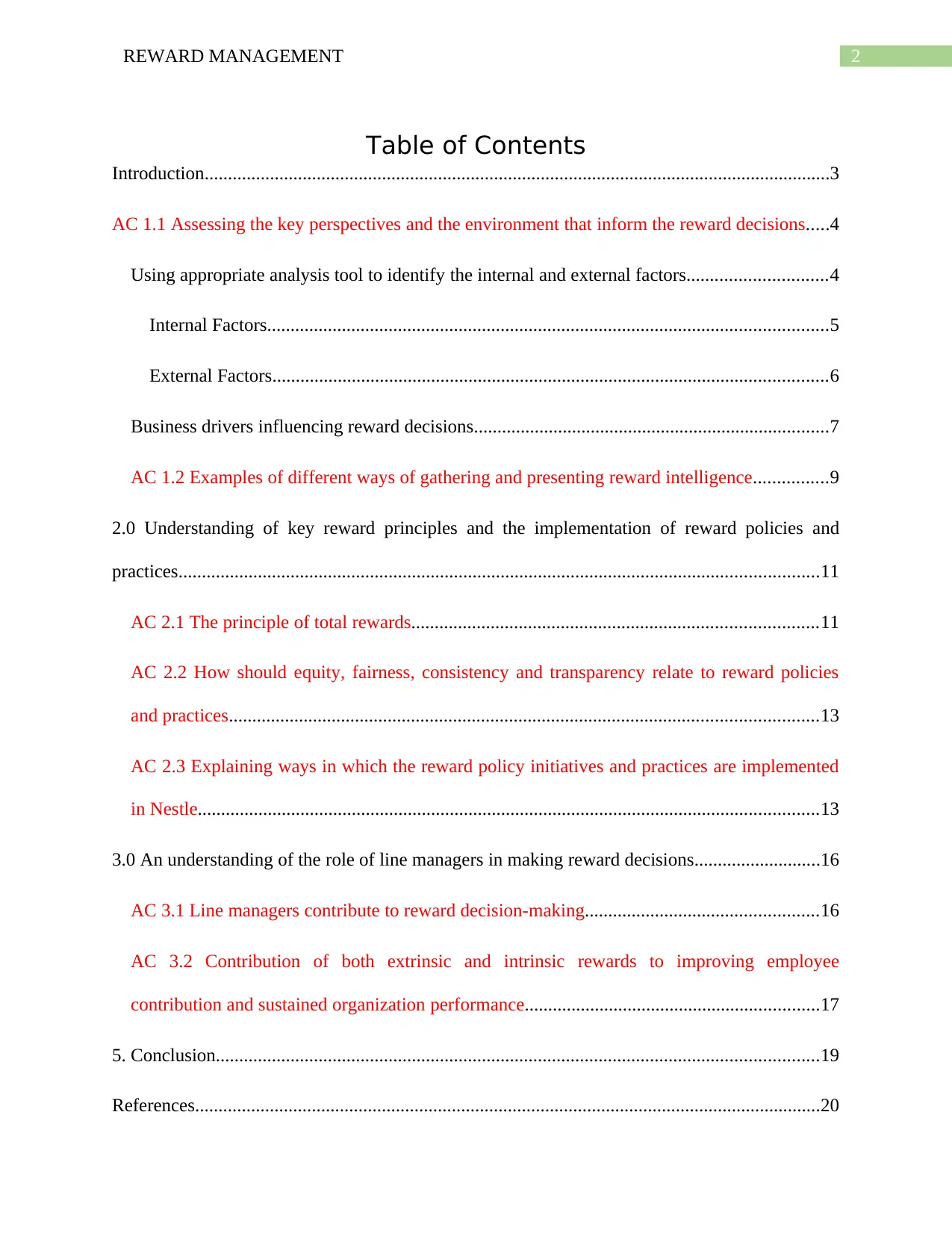
2REWARD MANAGEMENT
Table of Contents
Introduction......................................................................................................................................3
AC 1.1 Assessing the key perspectives and the environment that inform the reward decisions.....4
Using appropriate analysis tool to identify the internal and external factors..............................4
Internal Factors........................................................................................................................5
External Factors.......................................................................................................................6
Business drivers influencing reward decisions............................................................................7
AC 1.2 Examples of different ways of gathering and presenting reward intelligence................9
2.0 Understanding of key reward principles and the implementation of reward policies and
practices.........................................................................................................................................11
AC 2.1 The principle of total rewards.......................................................................................11
AC 2.2 How should equity, fairness, consistency and transparency relate to reward policies
and practices..............................................................................................................................13
AC 2.3 Explaining ways in which the reward policy initiatives and practices are implemented
in Nestle.....................................................................................................................................13
3.0 An understanding of the role of line managers in making reward decisions...........................16
AC 3.1 Line managers contribute to reward decision-making..................................................16
AC 3.2 Contribution of both extrinsic and intrinsic rewards to improving employee
contribution and sustained organization performance...............................................................17
5. Conclusion.................................................................................................................................19
References......................................................................................................................................20
Table of Contents
Introduction......................................................................................................................................3
AC 1.1 Assessing the key perspectives and the environment that inform the reward decisions.....4
Using appropriate analysis tool to identify the internal and external factors..............................4
Internal Factors........................................................................................................................5
External Factors.......................................................................................................................6
Business drivers influencing reward decisions............................................................................7
AC 1.2 Examples of different ways of gathering and presenting reward intelligence................9
2.0 Understanding of key reward principles and the implementation of reward policies and
practices.........................................................................................................................................11
AC 2.1 The principle of total rewards.......................................................................................11
AC 2.2 How should equity, fairness, consistency and transparency relate to reward policies
and practices..............................................................................................................................13
AC 2.3 Explaining ways in which the reward policy initiatives and practices are implemented
in Nestle.....................................................................................................................................13
3.0 An understanding of the role of line managers in making reward decisions...........................16
AC 3.1 Line managers contribute to reward decision-making..................................................16
AC 3.2 Contribution of both extrinsic and intrinsic rewards to improving employee
contribution and sustained organization performance...............................................................17
5. Conclusion.................................................................................................................................19
References......................................................................................................................................20
⊘ This is a preview!⊘
Do you want full access?
Subscribe today to unlock all pages.

Trusted by 1+ million students worldwide
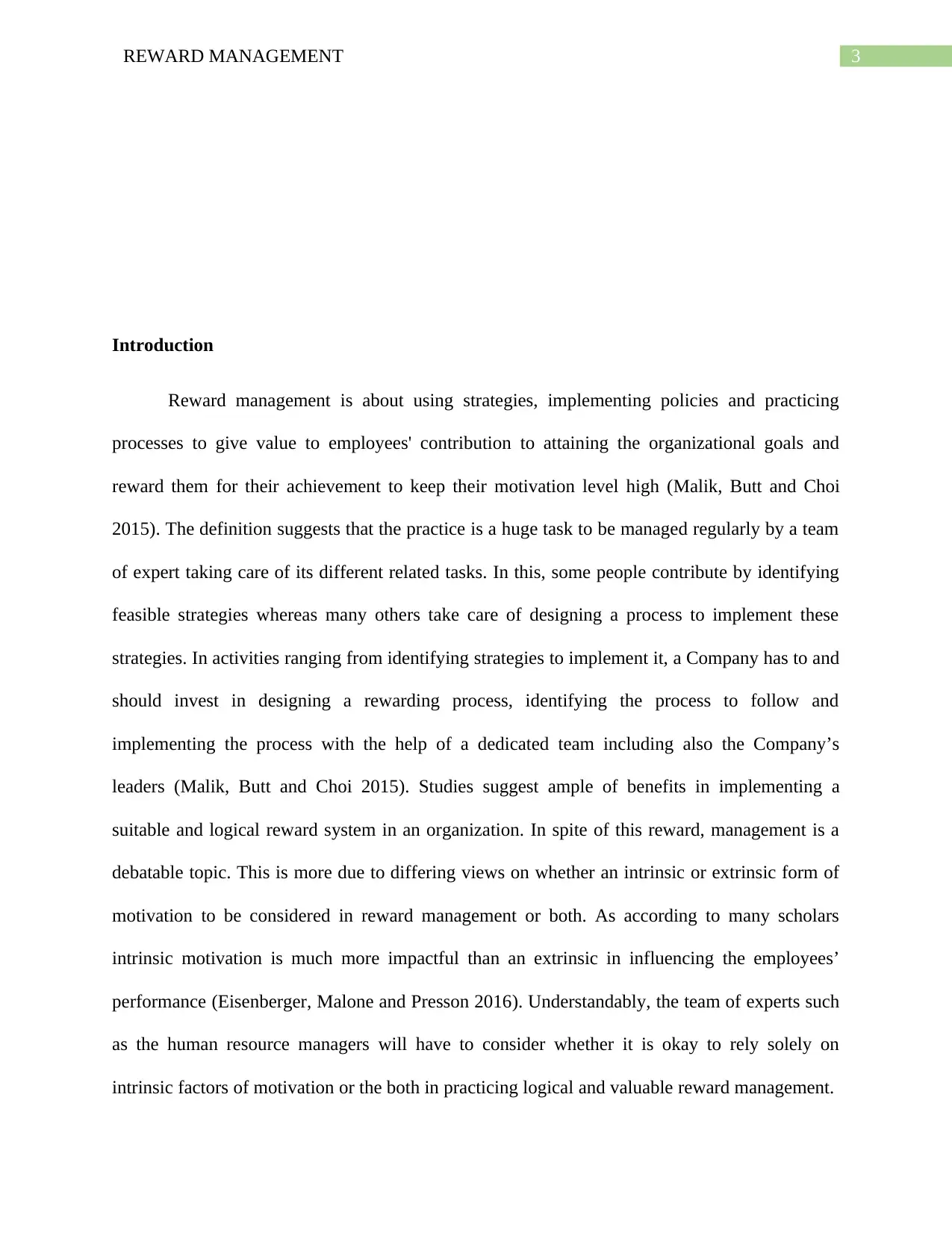
3REWARD MANAGEMENT
Introduction
Reward management is about using strategies, implementing policies and practicing
processes to give value to employees' contribution to attaining the organizational goals and
reward them for their achievement to keep their motivation level high (Malik, Butt and Choi
2015). The definition suggests that the practice is a huge task to be managed regularly by a team
of expert taking care of its different related tasks. In this, some people contribute by identifying
feasible strategies whereas many others take care of designing a process to implement these
strategies. In activities ranging from identifying strategies to implement it, a Company has to and
should invest in designing a rewarding process, identifying the process to follow and
implementing the process with the help of a dedicated team including also the Company’s
leaders (Malik, Butt and Choi 2015). Studies suggest ample of benefits in implementing a
suitable and logical reward system in an organization. In spite of this reward, management is a
debatable topic. This is more due to differing views on whether an intrinsic or extrinsic form of
motivation to be considered in reward management or both. As according to many scholars
intrinsic motivation is much more impactful than an extrinsic in influencing the employees’
performance (Eisenberger, Malone and Presson 2016). Understandably, the team of experts such
as the human resource managers will have to consider whether it is okay to rely solely on
intrinsic factors of motivation or the both in practicing logical and valuable reward management.
Introduction
Reward management is about using strategies, implementing policies and practicing
processes to give value to employees' contribution to attaining the organizational goals and
reward them for their achievement to keep their motivation level high (Malik, Butt and Choi
2015). The definition suggests that the practice is a huge task to be managed regularly by a team
of expert taking care of its different related tasks. In this, some people contribute by identifying
feasible strategies whereas many others take care of designing a process to implement these
strategies. In activities ranging from identifying strategies to implement it, a Company has to and
should invest in designing a rewarding process, identifying the process to follow and
implementing the process with the help of a dedicated team including also the Company’s
leaders (Malik, Butt and Choi 2015). Studies suggest ample of benefits in implementing a
suitable and logical reward system in an organization. In spite of this reward, management is a
debatable topic. This is more due to differing views on whether an intrinsic or extrinsic form of
motivation to be considered in reward management or both. As according to many scholars
intrinsic motivation is much more impactful than an extrinsic in influencing the employees’
performance (Eisenberger, Malone and Presson 2016). Understandably, the team of experts such
as the human resource managers will have to consider whether it is okay to rely solely on
intrinsic factors of motivation or the both in practicing logical and valuable reward management.
Paraphrase This Document
Need a fresh take? Get an instant paraphrase of this document with our AI Paraphraser
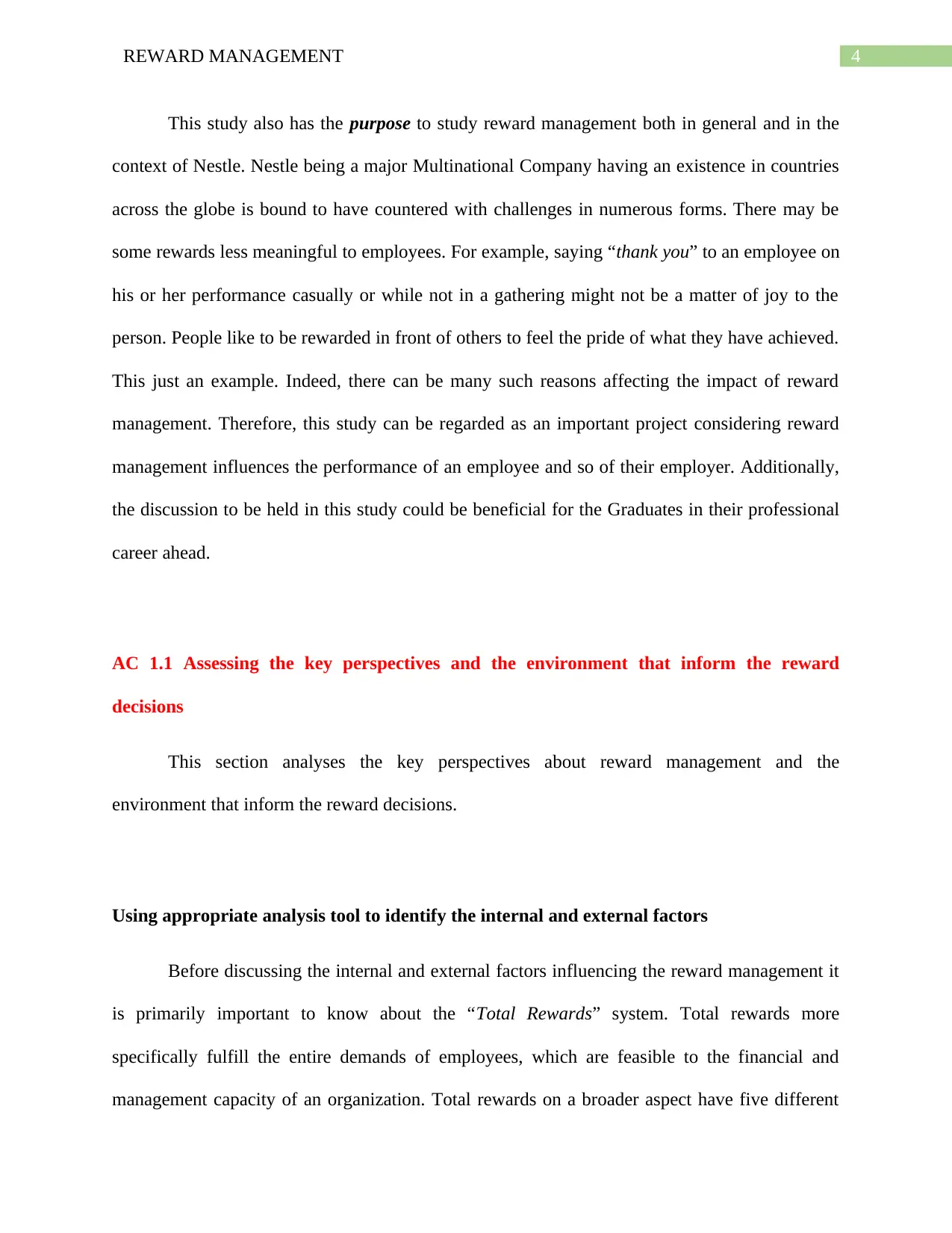
4REWARD MANAGEMENT
This study also has the purpose to study reward management both in general and in the
context of Nestle. Nestle being a major Multinational Company having an existence in countries
across the globe is bound to have countered with challenges in numerous forms. There may be
some rewards less meaningful to employees. For example, saying “thank you” to an employee on
his or her performance casually or while not in a gathering might not be a matter of joy to the
person. People like to be rewarded in front of others to feel the pride of what they have achieved.
This just an example. Indeed, there can be many such reasons affecting the impact of reward
management. Therefore, this study can be regarded as an important project considering reward
management influences the performance of an employee and so of their employer. Additionally,
the discussion to be held in this study could be beneficial for the Graduates in their professional
career ahead.
AC 1.1 Assessing the key perspectives and the environment that inform the reward
decisions
This section analyses the key perspectives about reward management and the
environment that inform the reward decisions.
Using appropriate analysis tool to identify the internal and external factors
Before discussing the internal and external factors influencing the reward management it
is primarily important to know about the “Total Rewards” system. Total rewards more
specifically fulfill the entire demands of employees, which are feasible to the financial and
management capacity of an organization. Total rewards on a broader aspect have five different
This study also has the purpose to study reward management both in general and in the
context of Nestle. Nestle being a major Multinational Company having an existence in countries
across the globe is bound to have countered with challenges in numerous forms. There may be
some rewards less meaningful to employees. For example, saying “thank you” to an employee on
his or her performance casually or while not in a gathering might not be a matter of joy to the
person. People like to be rewarded in front of others to feel the pride of what they have achieved.
This just an example. Indeed, there can be many such reasons affecting the impact of reward
management. Therefore, this study can be regarded as an important project considering reward
management influences the performance of an employee and so of their employer. Additionally,
the discussion to be held in this study could be beneficial for the Graduates in their professional
career ahead.
AC 1.1 Assessing the key perspectives and the environment that inform the reward
decisions
This section analyses the key perspectives about reward management and the
environment that inform the reward decisions.
Using appropriate analysis tool to identify the internal and external factors
Before discussing the internal and external factors influencing the reward management it
is primarily important to know about the “Total Rewards” system. Total rewards more
specifically fulfill the entire demands of employees, which are feasible to the financial and
management capacity of an organization. Total rewards on a broader aspect have five different
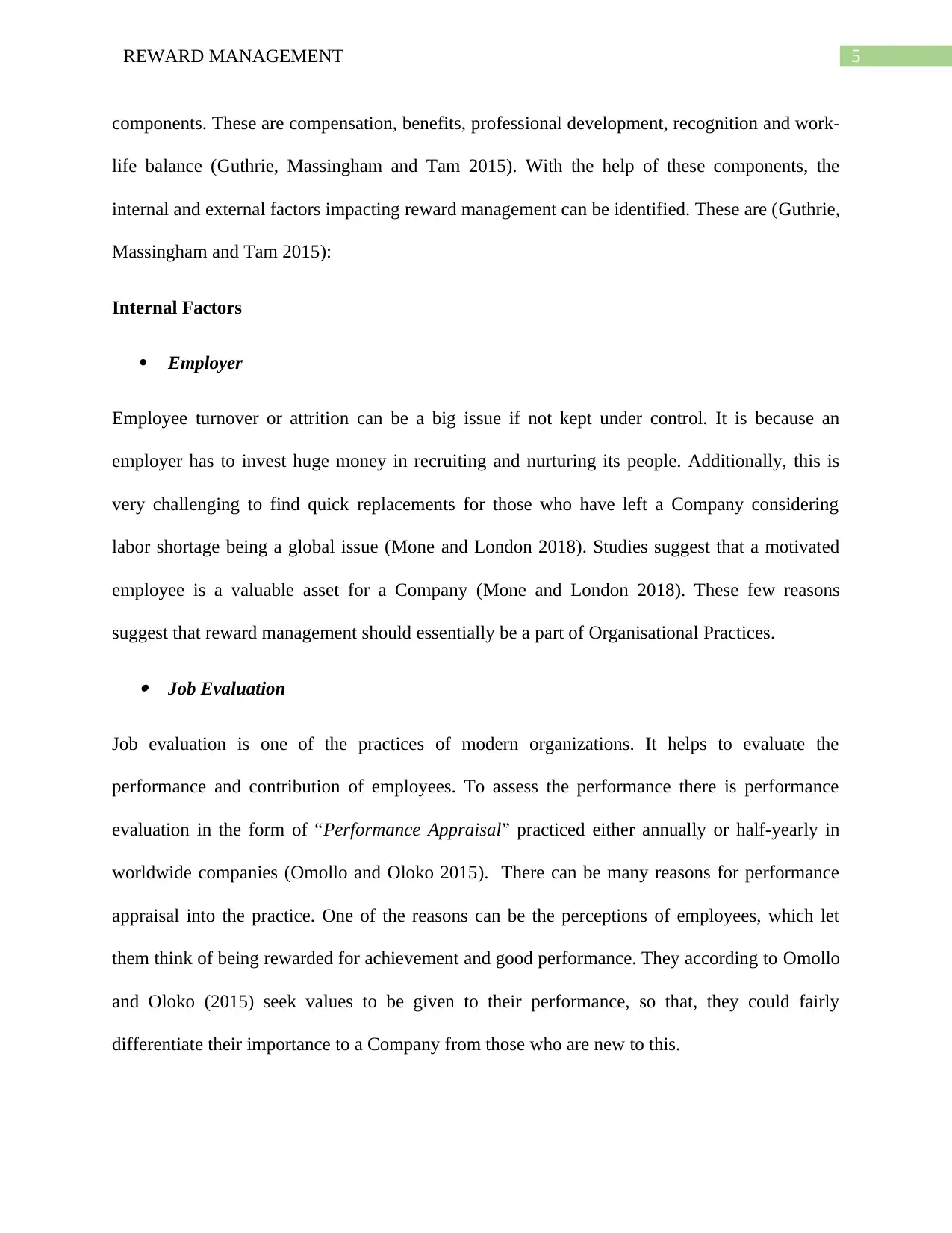
5REWARD MANAGEMENT
components. These are compensation, benefits, professional development, recognition and work-
life balance (Guthrie, Massingham and Tam 2015). With the help of these components, the
internal and external factors impacting reward management can be identified. These are (Guthrie,
Massingham and Tam 2015):
Internal Factors
Employer
Employee turnover or attrition can be a big issue if not kept under control. It is because an
employer has to invest huge money in recruiting and nurturing its people. Additionally, this is
very challenging to find quick replacements for those who have left a Company considering
labor shortage being a global issue (Mone and London 2018). Studies suggest that a motivated
employee is a valuable asset for a Company (Mone and London 2018). These few reasons
suggest that reward management should essentially be a part of Organisational Practices.
Job Evaluation
Job evaluation is one of the practices of modern organizations. It helps to evaluate the
performance and contribution of employees. To assess the performance there is performance
evaluation in the form of “Performance Appraisal” practiced either annually or half-yearly in
worldwide companies (Omollo and Oloko 2015). There can be many reasons for performance
appraisal into the practice. One of the reasons can be the perceptions of employees, which let
them think of being rewarded for achievement and good performance. They according to Omollo
and Oloko (2015) seek values to be given to their performance, so that, they could fairly
differentiate their importance to a Company from those who are new to this.
components. These are compensation, benefits, professional development, recognition and work-
life balance (Guthrie, Massingham and Tam 2015). With the help of these components, the
internal and external factors impacting reward management can be identified. These are (Guthrie,
Massingham and Tam 2015):
Internal Factors
Employer
Employee turnover or attrition can be a big issue if not kept under control. It is because an
employer has to invest huge money in recruiting and nurturing its people. Additionally, this is
very challenging to find quick replacements for those who have left a Company considering
labor shortage being a global issue (Mone and London 2018). Studies suggest that a motivated
employee is a valuable asset for a Company (Mone and London 2018). These few reasons
suggest that reward management should essentially be a part of Organisational Practices.
Job Evaluation
Job evaluation is one of the practices of modern organizations. It helps to evaluate the
performance and contribution of employees. To assess the performance there is performance
evaluation in the form of “Performance Appraisal” practiced either annually or half-yearly in
worldwide companies (Omollo and Oloko 2015). There can be many reasons for performance
appraisal into the practice. One of the reasons can be the perceptions of employees, which let
them think of being rewarded for achievement and good performance. They according to Omollo
and Oloko (2015) seek values to be given to their performance, so that, they could fairly
differentiate their importance to a Company from those who are new to this.
⊘ This is a preview!⊘
Do you want full access?
Subscribe today to unlock all pages.

Trusted by 1+ million students worldwide
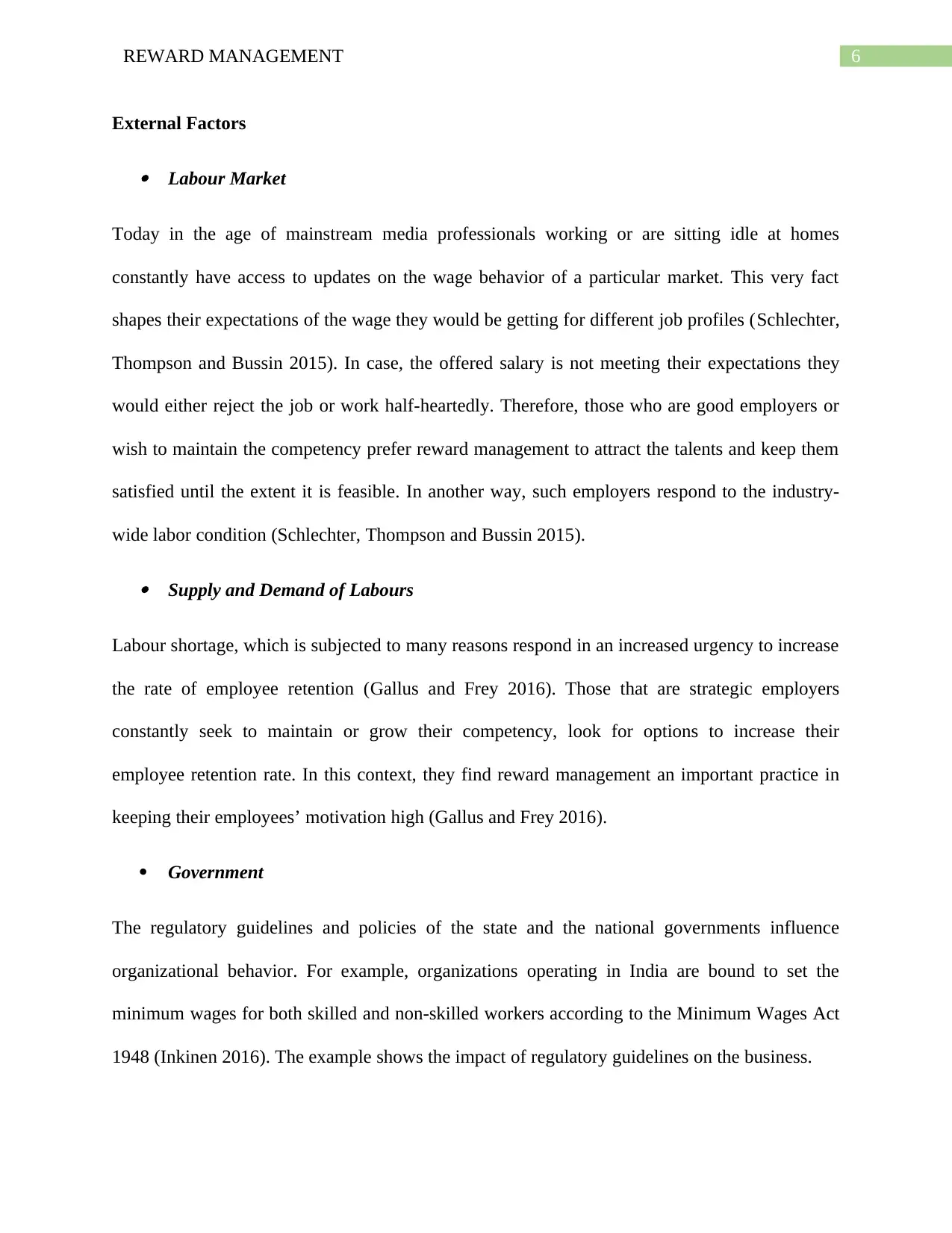
6REWARD MANAGEMENT
External Factors
Labour Market
Today in the age of mainstream media professionals working or are sitting idle at homes
constantly have access to updates on the wage behavior of a particular market. This very fact
shapes their expectations of the wage they would be getting for different job profiles (Schlechter,
Thompson and Bussin 2015). In case, the offered salary is not meeting their expectations they
would either reject the job or work half-heartedly. Therefore, those who are good employers or
wish to maintain the competency prefer reward management to attract the talents and keep them
satisfied until the extent it is feasible. In another way, such employers respond to the industry-
wide labor condition (Schlechter, Thompson and Bussin 2015).
Supply and Demand of Labours
Labour shortage, which is subjected to many reasons respond in an increased urgency to increase
the rate of employee retention (Gallus and Frey 2016). Those that are strategic employers
constantly seek to maintain or grow their competency, look for options to increase their
employee retention rate. In this context, they find reward management an important practice in
keeping their employees’ motivation high (Gallus and Frey 2016).
Government
The regulatory guidelines and policies of the state and the national governments influence
organizational behavior. For example, organizations operating in India are bound to set the
minimum wages for both skilled and non-skilled workers according to the Minimum Wages Act
1948 (Inkinen 2016). The example shows the impact of regulatory guidelines on the business.
External Factors
Labour Market
Today in the age of mainstream media professionals working or are sitting idle at homes
constantly have access to updates on the wage behavior of a particular market. This very fact
shapes their expectations of the wage they would be getting for different job profiles (Schlechter,
Thompson and Bussin 2015). In case, the offered salary is not meeting their expectations they
would either reject the job or work half-heartedly. Therefore, those who are good employers or
wish to maintain the competency prefer reward management to attract the talents and keep them
satisfied until the extent it is feasible. In another way, such employers respond to the industry-
wide labor condition (Schlechter, Thompson and Bussin 2015).
Supply and Demand of Labours
Labour shortage, which is subjected to many reasons respond in an increased urgency to increase
the rate of employee retention (Gallus and Frey 2016). Those that are strategic employers
constantly seek to maintain or grow their competency, look for options to increase their
employee retention rate. In this context, they find reward management an important practice in
keeping their employees’ motivation high (Gallus and Frey 2016).
Government
The regulatory guidelines and policies of the state and the national governments influence
organizational behavior. For example, organizations operating in India are bound to set the
minimum wages for both skilled and non-skilled workers according to the Minimum Wages Act
1948 (Inkinen 2016). The example shows the impact of regulatory guidelines on the business.
Paraphrase This Document
Need a fresh take? Get an instant paraphrase of this document with our AI Paraphraser
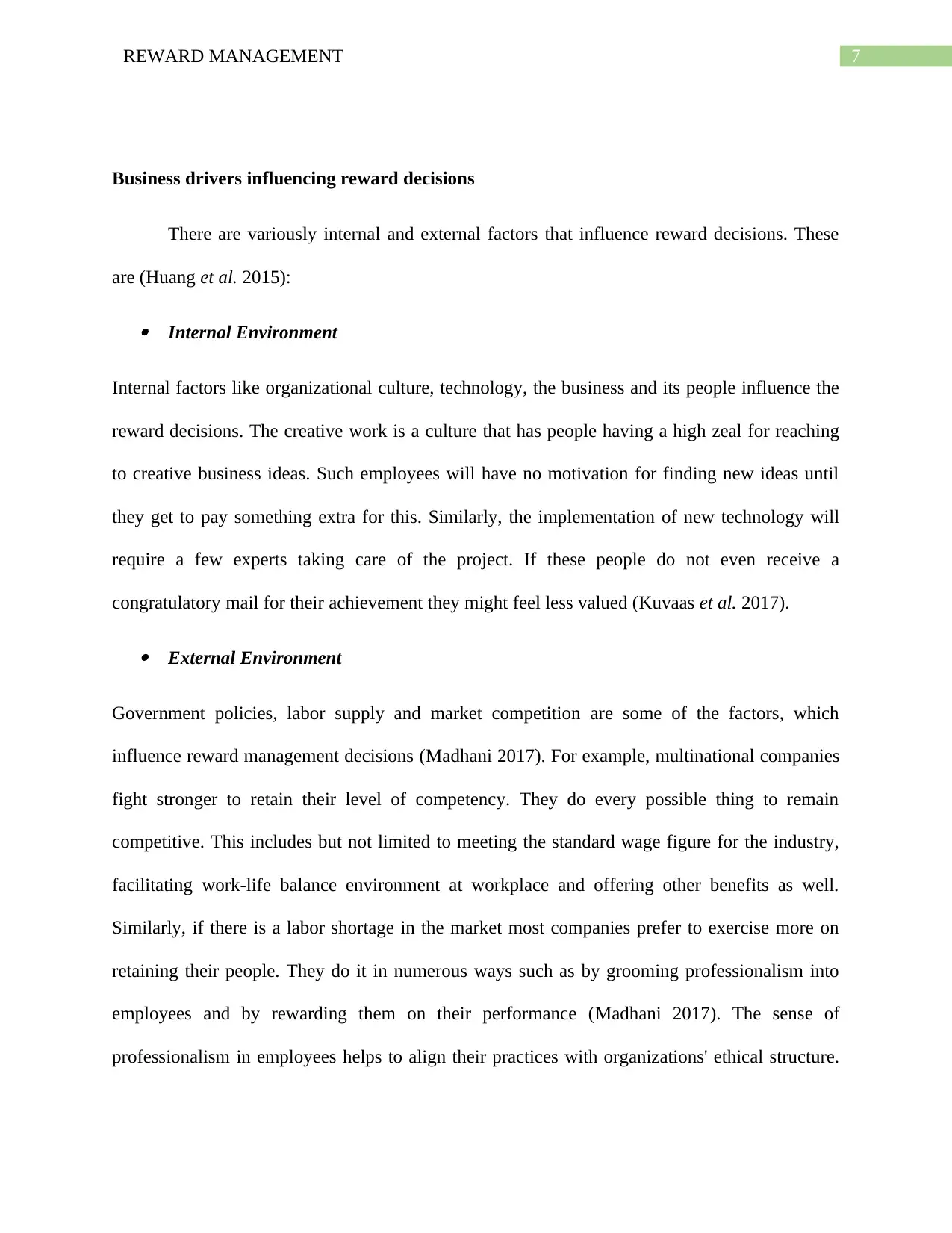
7REWARD MANAGEMENT
Business drivers influencing reward decisions
There are variously internal and external factors that influence reward decisions. These
are (Huang et al. 2015):
Internal Environment
Internal factors like organizational culture, technology, the business and its people influence the
reward decisions. The creative work is a culture that has people having a high zeal for reaching
to creative business ideas. Such employees will have no motivation for finding new ideas until
they get to pay something extra for this. Similarly, the implementation of new technology will
require a few experts taking care of the project. If these people do not even receive a
congratulatory mail for their achievement they might feel less valued (Kuvaas et al. 2017).
External Environment
Government policies, labor supply and market competition are some of the factors, which
influence reward management decisions (Madhani 2017). For example, multinational companies
fight stronger to retain their level of competency. They do every possible thing to remain
competitive. This includes but not limited to meeting the standard wage figure for the industry,
facilitating work-life balance environment at workplace and offering other benefits as well.
Similarly, if there is a labor shortage in the market most companies prefer to exercise more on
retaining their people. They do it in numerous ways such as by grooming professionalism into
employees and by rewarding them on their performance (Madhani 2017). The sense of
professionalism in employees helps to align their practices with organizations' ethical structure.
Business drivers influencing reward decisions
There are variously internal and external factors that influence reward decisions. These
are (Huang et al. 2015):
Internal Environment
Internal factors like organizational culture, technology, the business and its people influence the
reward decisions. The creative work is a culture that has people having a high zeal for reaching
to creative business ideas. Such employees will have no motivation for finding new ideas until
they get to pay something extra for this. Similarly, the implementation of new technology will
require a few experts taking care of the project. If these people do not even receive a
congratulatory mail for their achievement they might feel less valued (Kuvaas et al. 2017).
External Environment
Government policies, labor supply and market competition are some of the factors, which
influence reward management decisions (Madhani 2017). For example, multinational companies
fight stronger to retain their level of competency. They do every possible thing to remain
competitive. This includes but not limited to meeting the standard wage figure for the industry,
facilitating work-life balance environment at workplace and offering other benefits as well.
Similarly, if there is a labor shortage in the market most companies prefer to exercise more on
retaining their people. They do it in numerous ways such as by grooming professionalism into
employees and by rewarding them on their performance (Madhani 2017). The sense of
professionalism in employees helps to align their practices with organizations' ethical structure.
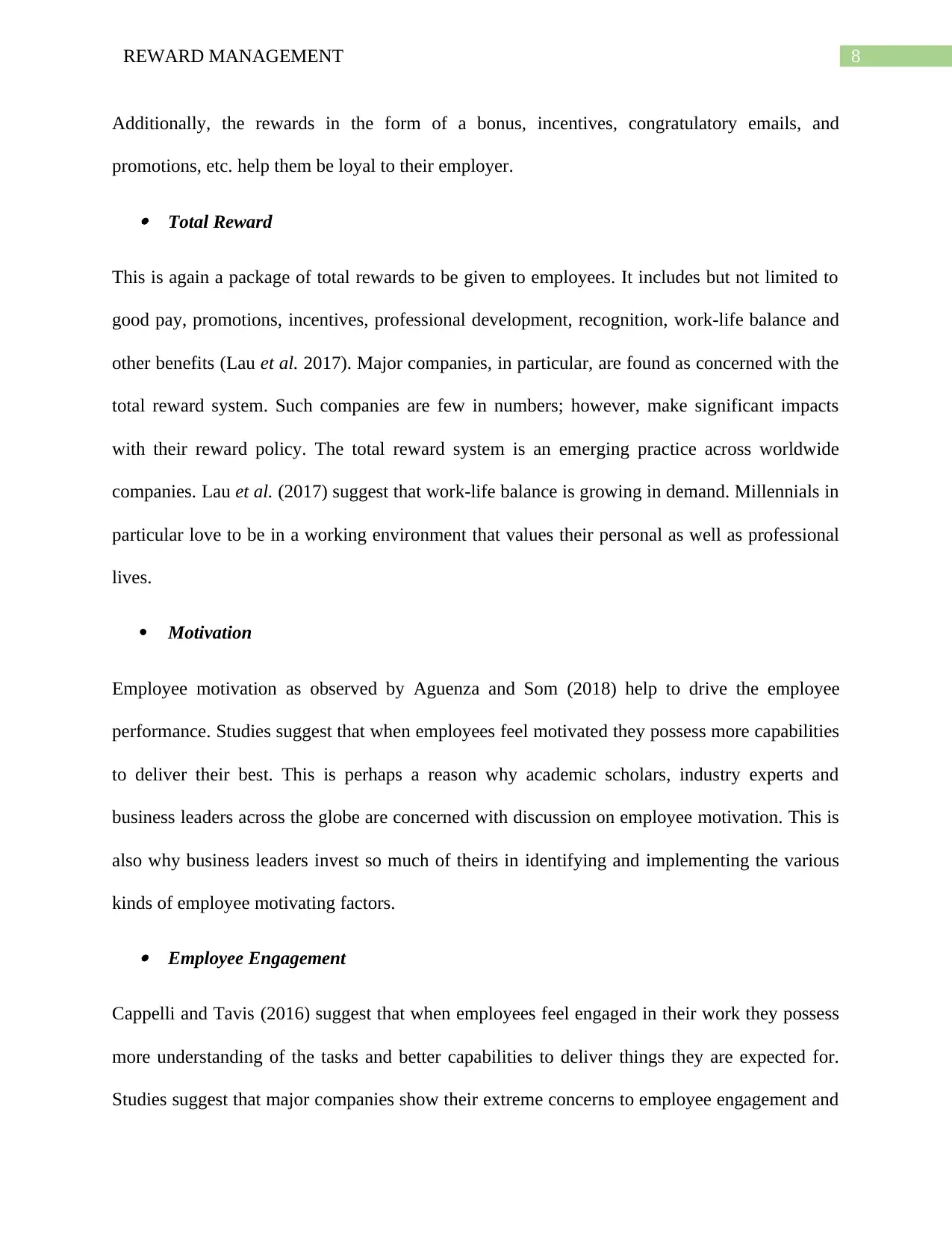
8REWARD MANAGEMENT
Additionally, the rewards in the form of a bonus, incentives, congratulatory emails, and
promotions, etc. help them be loyal to their employer.
Total Reward
This is again a package of total rewards to be given to employees. It includes but not limited to
good pay, promotions, incentives, professional development, recognition, work-life balance and
other benefits (Lau et al. 2017). Major companies, in particular, are found as concerned with the
total reward system. Such companies are few in numbers; however, make significant impacts
with their reward policy. The total reward system is an emerging practice across worldwide
companies. Lau et al. (2017) suggest that work-life balance is growing in demand. Millennials in
particular love to be in a working environment that values their personal as well as professional
lives.
Motivation
Employee motivation as observed by Aguenza and Som (2018) help to drive the employee
performance. Studies suggest that when employees feel motivated they possess more capabilities
to deliver their best. This is perhaps a reason why academic scholars, industry experts and
business leaders across the globe are concerned with discussion on employee motivation. This is
also why business leaders invest so much of theirs in identifying and implementing the various
kinds of employee motivating factors.
Employee Engagement
Cappelli and Tavis (2016) suggest that when employees feel engaged in their work they possess
more understanding of the tasks and better capabilities to deliver things they are expected for.
Studies suggest that major companies show their extreme concerns to employee engagement and
Additionally, the rewards in the form of a bonus, incentives, congratulatory emails, and
promotions, etc. help them be loyal to their employer.
Total Reward
This is again a package of total rewards to be given to employees. It includes but not limited to
good pay, promotions, incentives, professional development, recognition, work-life balance and
other benefits (Lau et al. 2017). Major companies, in particular, are found as concerned with the
total reward system. Such companies are few in numbers; however, make significant impacts
with their reward policy. The total reward system is an emerging practice across worldwide
companies. Lau et al. (2017) suggest that work-life balance is growing in demand. Millennials in
particular love to be in a working environment that values their personal as well as professional
lives.
Motivation
Employee motivation as observed by Aguenza and Som (2018) help to drive the employee
performance. Studies suggest that when employees feel motivated they possess more capabilities
to deliver their best. This is perhaps a reason why academic scholars, industry experts and
business leaders across the globe are concerned with discussion on employee motivation. This is
also why business leaders invest so much of theirs in identifying and implementing the various
kinds of employee motivating factors.
Employee Engagement
Cappelli and Tavis (2016) suggest that when employees feel engaged in their work they possess
more understanding of the tasks and better capabilities to deliver things they are expected for.
Studies suggest that major companies show their extreme concerns to employee engagement and
⊘ This is a preview!⊘
Do you want full access?
Subscribe today to unlock all pages.

Trusted by 1+ million students worldwide
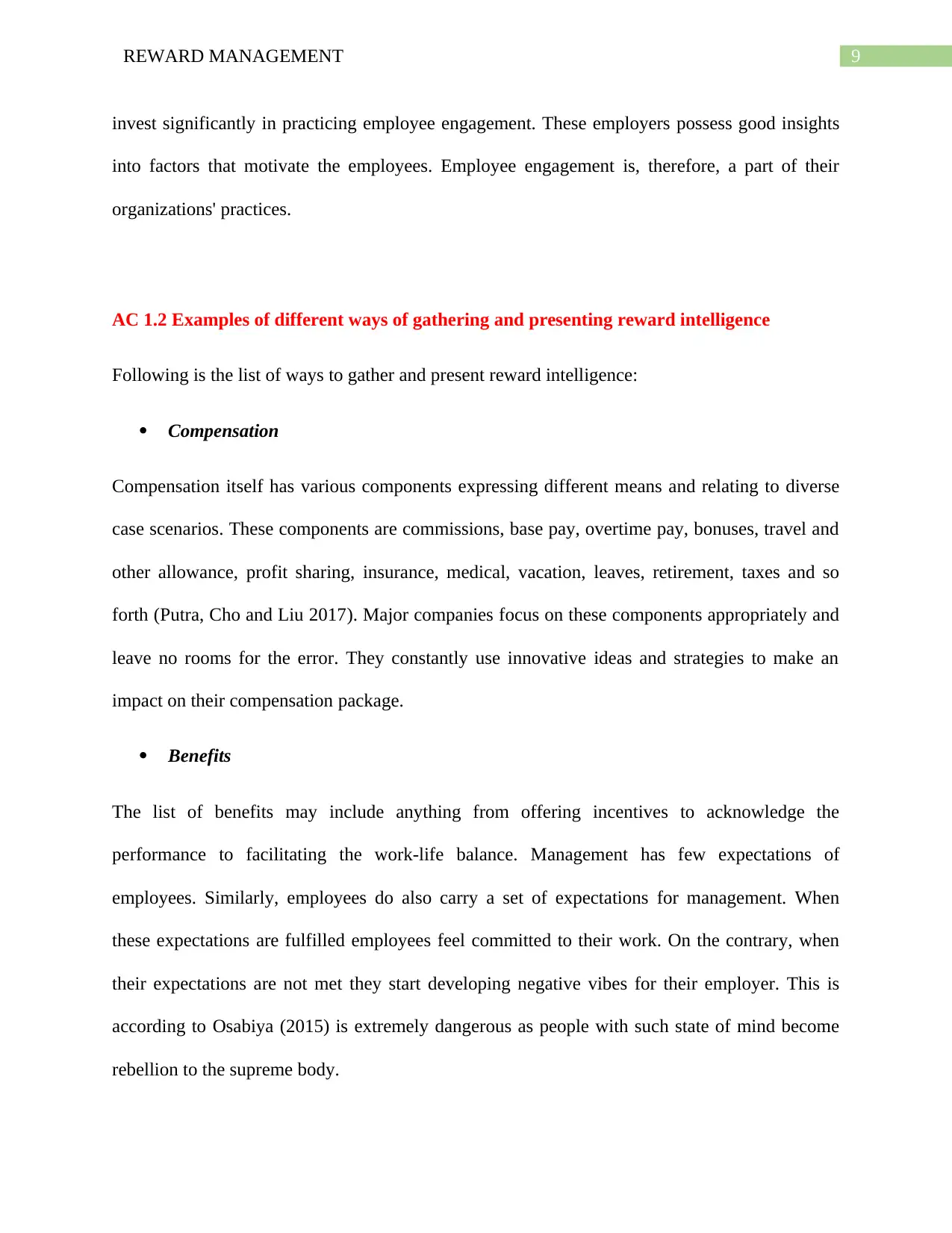
9REWARD MANAGEMENT
invest significantly in practicing employee engagement. These employers possess good insights
into factors that motivate the employees. Employee engagement is, therefore, a part of their
organizations' practices.
AC 1.2 Examples of different ways of gathering and presenting reward intelligence
Following is the list of ways to gather and present reward intelligence:
Compensation
Compensation itself has various components expressing different means and relating to diverse
case scenarios. These components are commissions, base pay, overtime pay, bonuses, travel and
other allowance, profit sharing, insurance, medical, vacation, leaves, retirement, taxes and so
forth (Putra, Cho and Liu 2017). Major companies focus on these components appropriately and
leave no rooms for the error. They constantly use innovative ideas and strategies to make an
impact on their compensation package.
Benefits
The list of benefits may include anything from offering incentives to acknowledge the
performance to facilitating the work-life balance. Management has few expectations of
employees. Similarly, employees do also carry a set of expectations for management. When
these expectations are fulfilled employees feel committed to their work. On the contrary, when
their expectations are not met they start developing negative vibes for their employer. This is
according to Osabiya (2015) is extremely dangerous as people with such state of mind become
rebellion to the supreme body.
invest significantly in practicing employee engagement. These employers possess good insights
into factors that motivate the employees. Employee engagement is, therefore, a part of their
organizations' practices.
AC 1.2 Examples of different ways of gathering and presenting reward intelligence
Following is the list of ways to gather and present reward intelligence:
Compensation
Compensation itself has various components expressing different means and relating to diverse
case scenarios. These components are commissions, base pay, overtime pay, bonuses, travel and
other allowance, profit sharing, insurance, medical, vacation, leaves, retirement, taxes and so
forth (Putra, Cho and Liu 2017). Major companies focus on these components appropriately and
leave no rooms for the error. They constantly use innovative ideas and strategies to make an
impact on their compensation package.
Benefits
The list of benefits may include anything from offering incentives to acknowledge the
performance to facilitating the work-life balance. Management has few expectations of
employees. Similarly, employees do also carry a set of expectations for management. When
these expectations are fulfilled employees feel committed to their work. On the contrary, when
their expectations are not met they start developing negative vibes for their employer. This is
according to Osabiya (2015) is extremely dangerous as people with such state of mind become
rebellion to the supreme body.
Paraphrase This Document
Need a fresh take? Get an instant paraphrase of this document with our AI Paraphraser
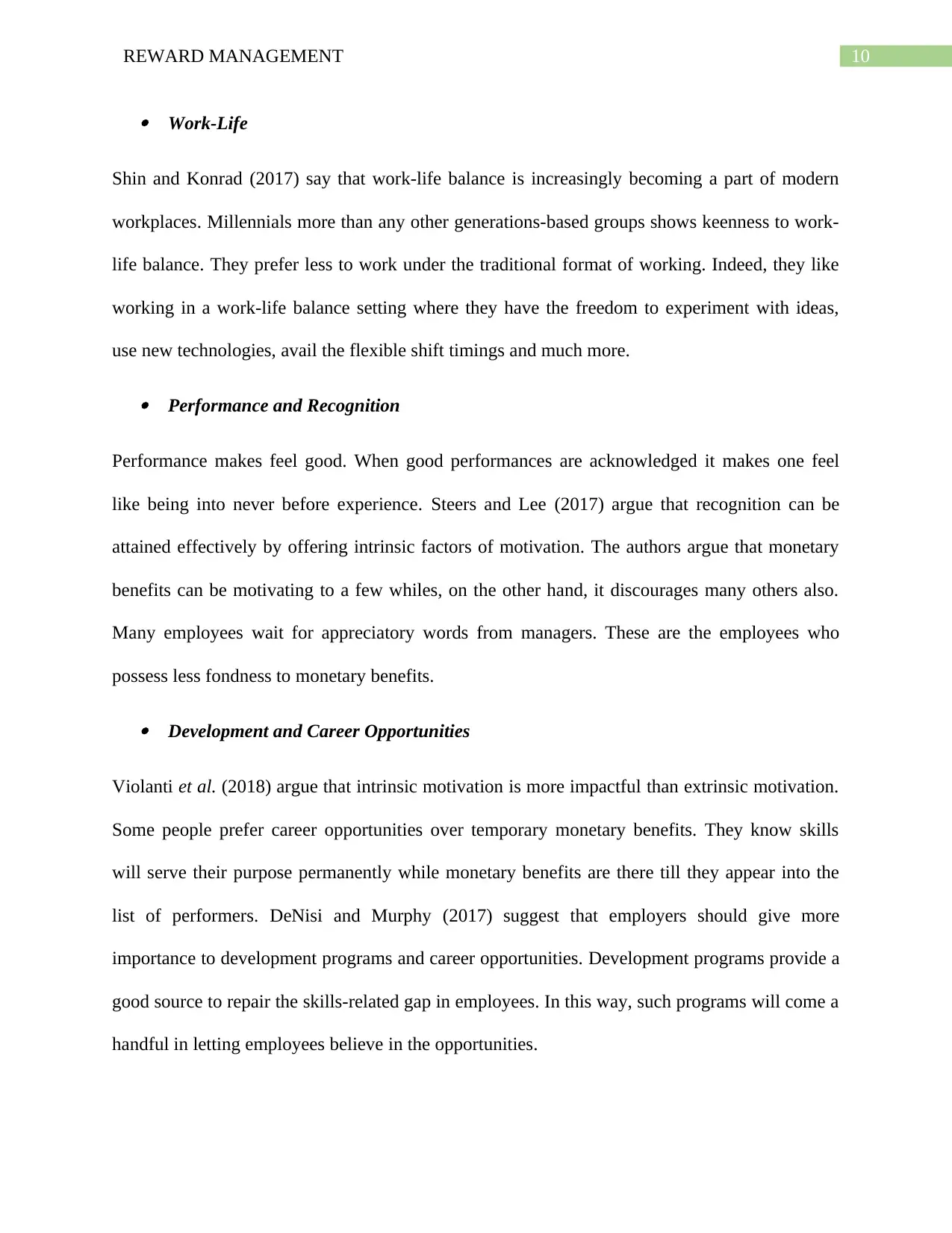
10REWARD MANAGEMENT
Work-Life
Shin and Konrad (2017) say that work-life balance is increasingly becoming a part of modern
workplaces. Millennials more than any other generations-based groups shows keenness to work-
life balance. They prefer less to work under the traditional format of working. Indeed, they like
working in a work-life balance setting where they have the freedom to experiment with ideas,
use new technologies, avail the flexible shift timings and much more.
Performance and Recognition
Performance makes feel good. When good performances are acknowledged it makes one feel
like being into never before experience. Steers and Lee (2017) argue that recognition can be
attained effectively by offering intrinsic factors of motivation. The authors argue that monetary
benefits can be motivating to a few whiles, on the other hand, it discourages many others also.
Many employees wait for appreciatory words from managers. These are the employees who
possess less fondness to monetary benefits.
Development and Career Opportunities
Violanti et al. (2018) argue that intrinsic motivation is more impactful than extrinsic motivation.
Some people prefer career opportunities over temporary monetary benefits. They know skills
will serve their purpose permanently while monetary benefits are there till they appear into the
list of performers. DeNisi and Murphy (2017) suggest that employers should give more
importance to development programs and career opportunities. Development programs provide a
good source to repair the skills-related gap in employees. In this way, such programs will come a
handful in letting employees believe in the opportunities.
Work-Life
Shin and Konrad (2017) say that work-life balance is increasingly becoming a part of modern
workplaces. Millennials more than any other generations-based groups shows keenness to work-
life balance. They prefer less to work under the traditional format of working. Indeed, they like
working in a work-life balance setting where they have the freedom to experiment with ideas,
use new technologies, avail the flexible shift timings and much more.
Performance and Recognition
Performance makes feel good. When good performances are acknowledged it makes one feel
like being into never before experience. Steers and Lee (2017) argue that recognition can be
attained effectively by offering intrinsic factors of motivation. The authors argue that monetary
benefits can be motivating to a few whiles, on the other hand, it discourages many others also.
Many employees wait for appreciatory words from managers. These are the employees who
possess less fondness to monetary benefits.
Development and Career Opportunities
Violanti et al. (2018) argue that intrinsic motivation is more impactful than extrinsic motivation.
Some people prefer career opportunities over temporary monetary benefits. They know skills
will serve their purpose permanently while monetary benefits are there till they appear into the
list of performers. DeNisi and Murphy (2017) suggest that employers should give more
importance to development programs and career opportunities. Development programs provide a
good source to repair the skills-related gap in employees. In this way, such programs will come a
handful in letting employees believe in the opportunities.
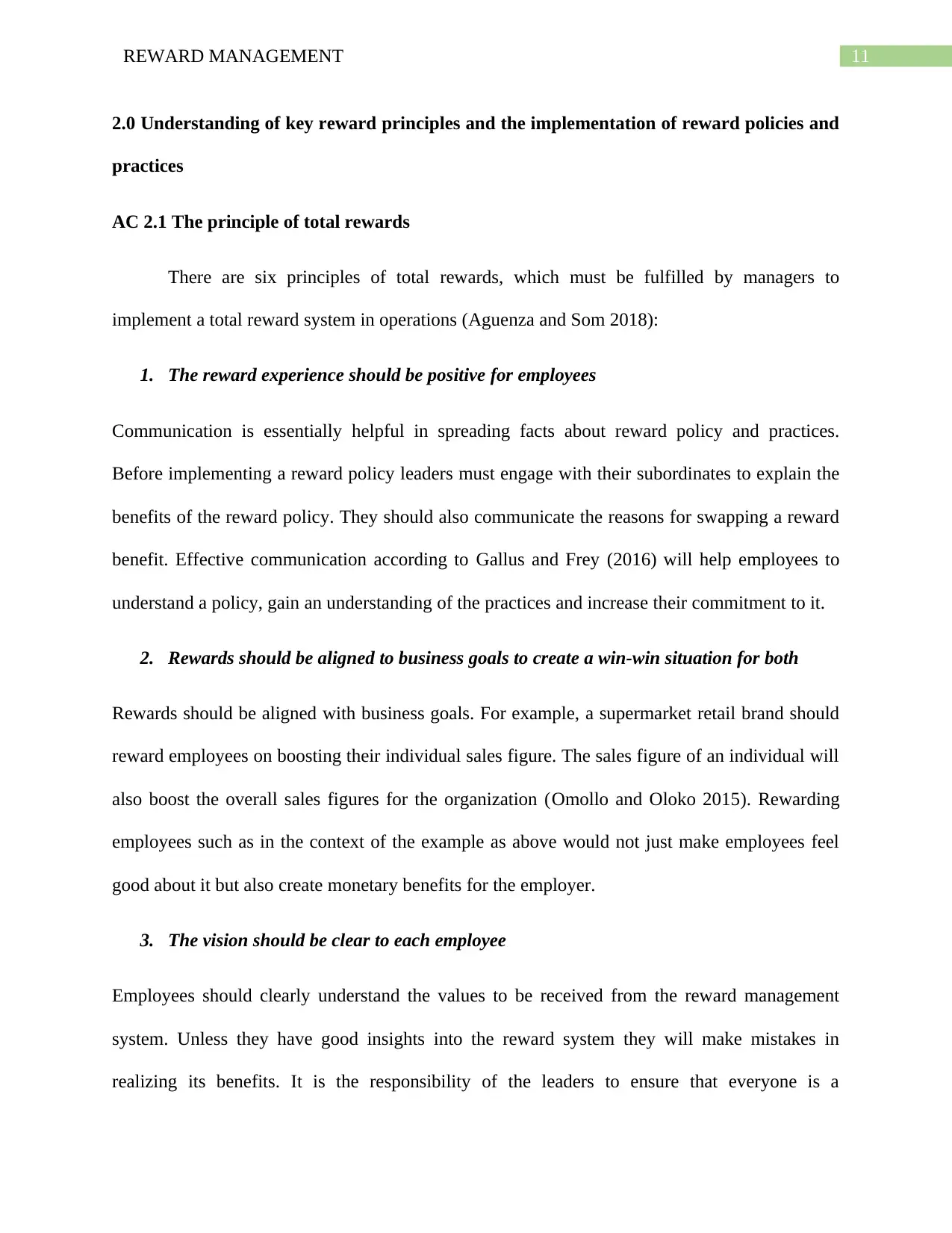
11REWARD MANAGEMENT
2.0 Understanding of key reward principles and the implementation of reward policies and
practices
AC 2.1 The principle of total rewards
There are six principles of total rewards, which must be fulfilled by managers to
implement a total reward system in operations (Aguenza and Som 2018):
1. The reward experience should be positive for employees
Communication is essentially helpful in spreading facts about reward policy and practices.
Before implementing a reward policy leaders must engage with their subordinates to explain the
benefits of the reward policy. They should also communicate the reasons for swapping a reward
benefit. Effective communication according to Gallus and Frey (2016) will help employees to
understand a policy, gain an understanding of the practices and increase their commitment to it.
2. Rewards should be aligned to business goals to create a win-win situation for both
Rewards should be aligned with business goals. For example, a supermarket retail brand should
reward employees on boosting their individual sales figure. The sales figure of an individual will
also boost the overall sales figures for the organization (Omollo and Oloko 2015). Rewarding
employees such as in the context of the example as above would not just make employees feel
good about it but also create monetary benefits for the employer.
3. The vision should be clear to each employee
Employees should clearly understand the values to be received from the reward management
system. Unless they have good insights into the reward system they will make mistakes in
realizing its benefits. It is the responsibility of the leaders to ensure that everyone is a
2.0 Understanding of key reward principles and the implementation of reward policies and
practices
AC 2.1 The principle of total rewards
There are six principles of total rewards, which must be fulfilled by managers to
implement a total reward system in operations (Aguenza and Som 2018):
1. The reward experience should be positive for employees
Communication is essentially helpful in spreading facts about reward policy and practices.
Before implementing a reward policy leaders must engage with their subordinates to explain the
benefits of the reward policy. They should also communicate the reasons for swapping a reward
benefit. Effective communication according to Gallus and Frey (2016) will help employees to
understand a policy, gain an understanding of the practices and increase their commitment to it.
2. Rewards should be aligned to business goals to create a win-win situation for both
Rewards should be aligned with business goals. For example, a supermarket retail brand should
reward employees on boosting their individual sales figure. The sales figure of an individual will
also boost the overall sales figures for the organization (Omollo and Oloko 2015). Rewarding
employees such as in the context of the example as above would not just make employees feel
good about it but also create monetary benefits for the employer.
3. The vision should be clear to each employee
Employees should clearly understand the values to be received from the reward management
system. Unless they have good insights into the reward system they will make mistakes in
realizing its benefits. It is the responsibility of the leaders to ensure that everyone is a
⊘ This is a preview!⊘
Do you want full access?
Subscribe today to unlock all pages.

Trusted by 1+ million students worldwide
1 out of 23
Related Documents
Your All-in-One AI-Powered Toolkit for Academic Success.
+13062052269
info@desklib.com
Available 24*7 on WhatsApp / Email
![[object Object]](/_next/static/media/star-bottom.7253800d.svg)
Unlock your academic potential
Copyright © 2020–2025 A2Z Services. All Rights Reserved. Developed and managed by ZUCOL.





